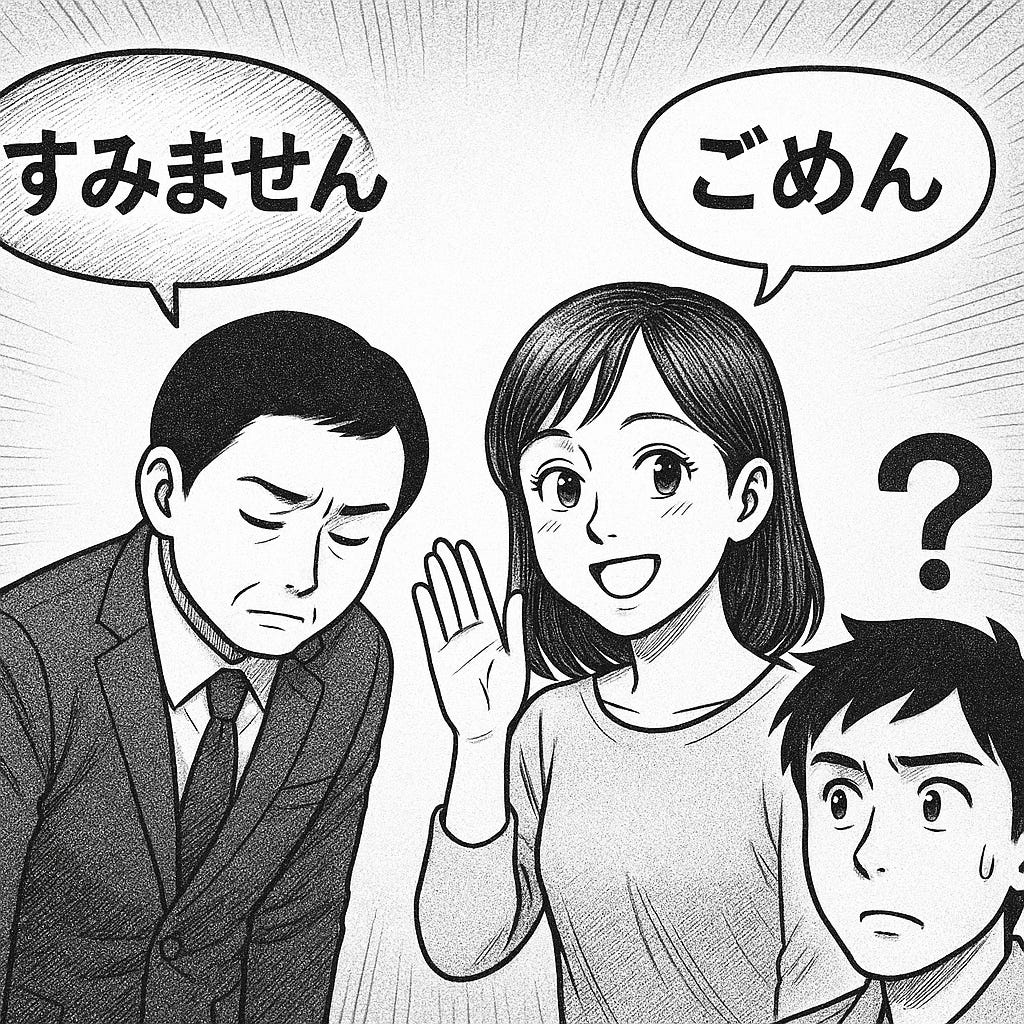Q&A Friday: When Is “Sumimasen” Too Formal and “Gomen” Too Casual?
A deep dive into the emotional logic behind Japanese apologies and how each choice shapes the relationship.
One of the first things people notice when they come to Japan is just how often we apologize.
But here’s the real question: How many kinds of “sorry” do we actually use, and how do we know which one sounds right in the moment?
A great question came up recently on Reddit:
“When is ‘sumimasen’ too formal and ‘gomen’ too casual? Where’s the line?”
As a native speaker, I realized how often we switch between apology phrases almost unconsciously.
So today, I’d like to unpack the unspoken logic behind those choices by exploring how we read the room, weigh relationships, and instinctively adjust our tone when saying sorry.
🎯 Why It’s Tricky
Japanese has no single equivalent for “sorry.” Instead, we have a spectrum of phrases that shift in tone, weight, and humility depending on:
How close you are to the person
How serious your mistake is
You might know common phrases like:
ごめん (casual “sorry”)
すみません (polite but versatile)
申し訳ありません (formal, weighty)
But how do we actually use them? And what are the invisible lines?
🗺️ Mapping the Apology Landscape
I’ve created a simple matrix to visualize how I personally apologize in each situation.
Each row corresponds to a specific scenario, and each column reflects a tone or word choice I might use depending on context.
🔍 The chart’s packed — so don’t hesitate to pinch or zoom in if you're on mobile!
A Quick Note: 「申し訳ありません」 vs 「申し訳ないです」
Both phrases technically mean “I’m terribly sorry,” but they differ in tone and formality.
申し訳ありません is the gold standard for formal apologies. It’s crisp, traditional, and expected in business, customer service, or when speaking to someone above you. Think: set phrases used in professional contexts.
申し訳ないです sounds a bit softer and more modern, but also slightly off-register to some ears. It’s occasionally heard in casual business speech, especially among younger speakers, but some people still feel it lacks the polished edge of「申し訳ありません」.
📌 If in doubt, go with 申し訳ありません. It’s safer, more formal, and universally accepted even if it sounds a little templated.
✨ Beyond the Matrix: Apology Tips in Japanese
While the matrix shows how I personally navigate different apology situations, it doesn’t capture the deeper cultural expectations that shape how apologies are received in Japan.
Here are three key principles I’ve found essential regardless of which phrase you use.
1. Specificity matters.
No matter what phrase you use, the most important part of an apology in Japanese is to clearly state what you’re apologizing for.
✅ 「遅(おく)れてしまって、すみませんでした。」
✅ 「確認(かくにん)せず送(おく)ってしまい、申し訳(もうしわけ)ありません。」
Without this, the listener may wonder “Are you just saying this to move on?”
2. Tone > Words
Even a simple “ごめん” can sound sincere, if said earnestly. Likewise, “申し訳ありません” can sound cold if rushed or mumbled.
3. Adding intent matters
Pairing apologies with phrases like:
「今後(こんご)気をつけます」(I’ll be more careful)
「二度(にど)と繰り返(くりかえ)さないようにします」(It won’t happen again)
can greatly increase your perceived sincerity.
🧩 Takeaway
Japanese apologies are not one-size-fits-all.
They shift based on:
Who you’re talking to
How serious the situation is
How much accountability you show
Words like 「すみません」 or 「ごめん」 may seem simple. But when used with care and clarity, they carry far more weight than textbooks let on.
It’s not just about the words.
It’s about understanding the relationship and responsibility behind them.
💬 Enjoyed this piece? Leave a thought below or share it with someone who's navigating Japanese culture too.
Want to learn the rare, stylish, and sometimes hilarious ways Japanese people apologize?
Stay tuned for this Saturday’s bonus post (for paid subscribers).
✨ Enjoyed this post?
Help shape future posts by answering a quick 1-minute reader survey.
Your feedback really helps!





